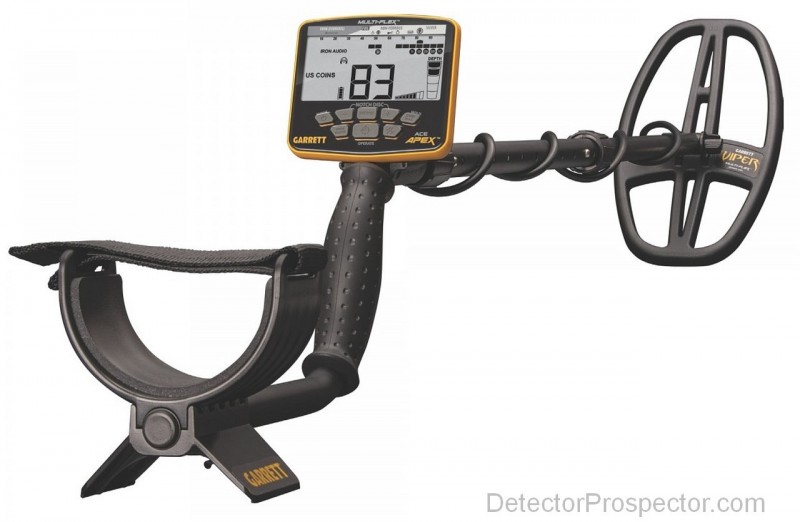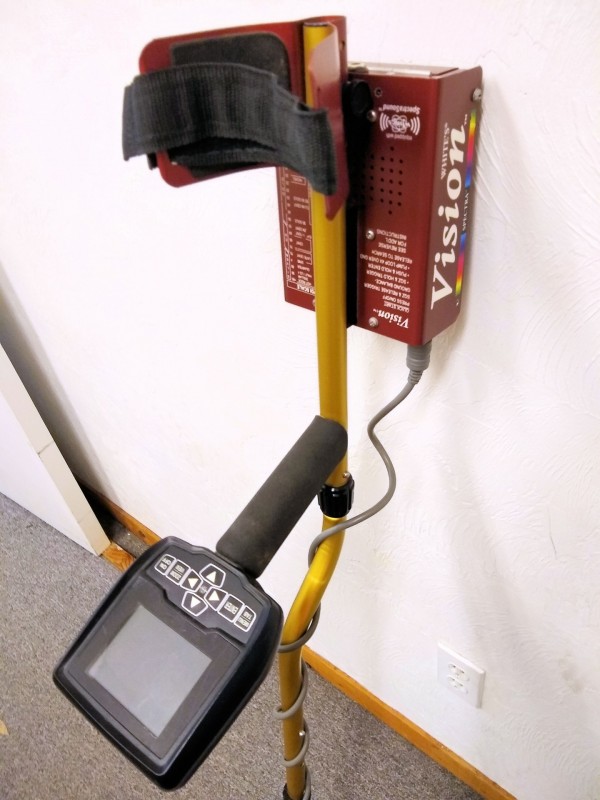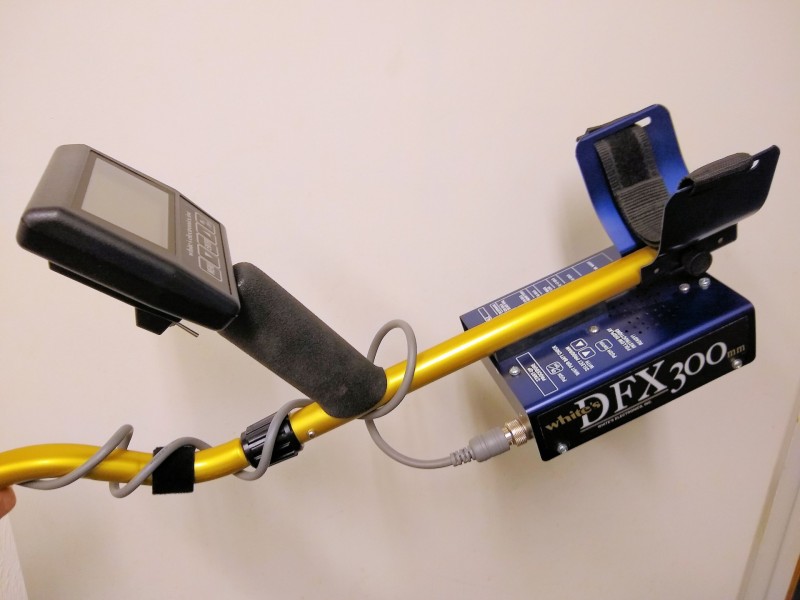-
Posts
584 -
Joined
-
Last visited
Content Type
Forums
Detector Prospector Home
Detector Database
Downloads
Everything posted by Geotech
-

White's V3i And Vx3 Factory Master Reset
Geotech replied to Steve Herschbach's topic in White's Metal Detectors
locator, if someone got into the calibration and actually ran it, then very likely the unit will not be able to ground balance. You can check this by pulling the trigger switch and bobbing the coil over mineralized ground (autotrac enabled). If it responds a few times and then settles down to no-response, then you're good. You can also look at known coin VDIs but I'm not sure how much they would vary with a bad cal. Calibration is for coil offset, ferrite (ground), and salt. You can actually do it yourself at home, if you know how. 😉 It was nice to see Bob again (video), he passed away a little over a year ago. I miss the old codger. -
0.213g is 3.3 grains, which is #4 birdshot. And that's what it looks like, too. #9 is 0.75 grains which roughly emulates a 0.5 grain gold nugget. I like to use shot because it's consistent, real nuggets are not. If possible, I'd like to send you a few shot sizes to test on the QED. I'm curious about its sensitivity. The next stop for the Impulse train is a nugget hunter and the goal is #9 shot.
-
I also tried to contact Vince many months ago but never got a reply. The realtor was no help. Might try to find a way to contact Rusty Henry.
-
Mostly unnecessary. Two frequencies help but only if they are spaced far enough apart. The CZ was 1:3, the DFX was 1:5, BBS/FBS is 1:8, V3 is 1:3:9. 1:3 is marginally minimum, higher is better. Honestly, the V3 would probably have been better without the middle frequency. The main reason for it was to perform zero-motion disc, a feature that never made it to production. With 5, 10, 15, and 20 kHz, 5+20 (1:4) makes the most sense, although 5+15 might be a little more stable in salt. It would not make sense to throw in e.g. 10kHz as there is practically no additional useful information and it marginally reduces depth.
-
When I was at White's I did a comprehensive test of target recovery speeds for maybe 40 different detectors from all the manufacturers. The best of all I tested was the AT-Gold, with the Tejon (I think it was) slightly behind. Most all the other detectors were clustered in the "mundane range". Mind you, this was maybe 10 yrs ago before a lot of newer models came along, and the XP Deus I had was on the original firmware. But I expect the AT-Gold I tested would still rank amongst the best, so I would have to say that Garrett knows how to do recovery speed.
-
Either way can achieve fast reactivity. Harder, yes. Better, depends. Analog demodulation can perform as well as direct sampling. Direct sampling is mostly a way to reduce parts and make a smaller design, although it does allow demodulation with funny waveforms. No idea if the Eq does that. No, it's just interesting speculation, especially considering Garrett chose the same frequencies. The Garrett patent could be a utility patent (technology) or a design patent (look & feel). They did both on their pinpointer, both in regards to the enclosure, but then never enforced those patents when clones started showing up. So I'm not sure why they would bother with a patent.
-
I don't recall any patents specific to Multi-IQ. Multi-IQ is direct sampling which means everything worthwhile is done in the micro. It's probably better to not patent any of that because then you have to reveal it. I would be surprised if Garrett went straight to direct sampling multifrequency, that's quite a difficult jump. More likely, they used analog demods and that approach has been around a while. Ergo, I see no patent concerns for them.
-
First of all, "power" is a wrong metric for metal detectors. A single-frequency VLF with a perfect TX coil will transmit zero power since all the current gets recycled. A traditional PI has a total loss transmitter but even then "power" doesn't make much sense. For the "transmit strength," yes, it is current that matters along with the number of turns of the TX coil. We call that the "ampere-turns" (N*I) and the TX magnetic field is proportional to N*I for a given coil size. It doesn't matter what the driving voltage is except that it is part of the system design. As Pimento suggests, you can't look at the battery current and tell anything. TX pulse width and pulse frequency also combine with peak TX current to determine average battery draw. And once you know the peak current, that doesn't necessarily reflect actual performance. For small nugget detection you need to be able to sample early and the higher the peak current the harder it is to do that. Early sampling isn't important for an Atocha bar detector so you can dump 100 amps of current through the coil, but that same system might not be able to detect any nuggets smaller than, say, an ounce. At all. Finally, there are methods of energy recycling in PI detectors, although not yet prevalent in production models. Another reason why you can't look at battery consumption and determine anything.
-

Identification Help Needed
Geotech replied to GB_Amateur's topic in Metal Detecting For Coins & Relics
Either what Paul said, or it's a hammer from a kid's tool kit. Probably made of pot metal. -

Help Pcb Fisher Gold Bug 2
Geotech replied to arcanomistero's topic in First Texas - Bounty Hunter, Fisher & Teknetics
That circuit is definitely not a Goldbug 2. As Steve said, it is probably some other detector circuit they stuffed inside. Therefore, there is nothing you can do. The GB pot and switches cannot be soldered in. -
The V3 is one of my favorite designs. By the time the V3i rolled out we had identified ways to improve both depth & tracking but both required hardware redesign. Plus had some really cool things we were gonna put in for the V4, there is a patent somewhere that alludes to some of this. But, alas, it was not to be.
-
The V3 & VX3 are/were living on borrowed time. The main processor, wireless module, and color display have all been obsoleted by their manufacturers. Probably the VX3 was killed first since the V3 is more profitable.
-
I once pitched to White's the idea of custom detectors. To demonstrate, I made a Garnet-and-Gold (FSU) Vision/V3 and a Blue-and-Gold DFX. I took raw metal to a local anodizer, then had the factory build out the units including stenciling. They were stunning but a 20% mark-up for this would have severely limited appeal. I tried a bit harder to get White's to consider custom coil options, and even custom packages (pinpointer, headphones, digger, etc.). They just didn't have the logistics in place to make it reasonably easy. Same for First Texas.
-

Where Is Fisher On The Impulse?
Geotech replied to PPP's topic in First Texas - Bounty Hunter, Fisher & Teknetics
And it might be said 6 months from now. It is what it is. -

Detecting Forum Website Popularity
Geotech replied to Steve Herschbach's topic in Detector Prospector Forum
Hey, with a little more effort I could have Geotech in the top 2 million! -

Where Is Fisher On The Impulse?
Geotech replied to PPP's topic in First Texas - Bounty Hunter, Fisher & Teknetics
Outside of myself, I doubt there is anyone in FTP who pays much attention to forums. They mostly focus on Facebook & such. I try not to say much because I've been chastised a few times in the past for doing so. Rick & LeJag have a bit more leeway. -

Where Is Fisher On The Impulse?
Geotech replied to PPP's topic in First Texas - Bounty Hunter, Fisher & Teknetics
Wish I had more info to offer, but I don't. There is no question the Impulse is difficult to build, and is quite different from what the FT factory is used to producing. That is a big part of the problem. But I have no doubt that the Impulse will make it out the door. Don't ask me when, I really don't know. P.S. -- the Fisher web site will soon get a major facelift. -

White’s 24K And More Voltage To The Coil?
Geotech replied to Gerry in Idaho's topic in White's Metal Detectors
Mathematically, a 50% increase in drive voltage will produce a 7% increase in depth. This assumes far-field. Very close and very tiny targets can show a bigger impact. -
Which of those frequencies are used for the Nox's MF modes?




